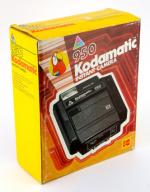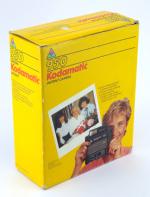|
Kodak Kodamatic 950 |
Manufactured or assembled in Germany from 1983 to 1985.
Index of rarity in France: Frequent (among non-specialized garage sales)
Inventory number: 426
See the complete technical specifications
Chronology of cameras Kodak
In 1976, Kodak aimed to grab a share of the instant photography market, which Polaroid nearly monopolized.
Kodak relied on a new in-house film, the PR10, presented in packs of 10 photos sized 7 x 9 cm. The operation mode of Kodak's cameras closely resembled that of the competitor. Polaroid saw it as plagiarism, without regard for patents, and sued Kodak. The trial lasted more than 10 years, and in the meantime, Kodak released numerous models accompanied by intense advertising campaigns:
Kodak instant photography was introduced in France on May 23, 1977, although it was available in North America as early as 1976. The first range available in France consisted of the EK4, EK6, and EK8.
| Year | American name | Made in | Film | |||
| EK4 |  |
1976-78 | USA | Kodamatic PR 144/10 (160 ISO) |
Manual photo ejection | |
| EK6 |  |
1976-78 | USA | Automatic photo ejection | ||
| EK8 |  |
1977-79 | Germany | |||
| EK2 | 1977-78 | The Handle | USA/UK | |||
| 1978-79 | Happy Times (Coca-Cola) | USA | Promotional version of the EK2 | |||
| 1977-82 | Pleaser | USA | Promotional version of the EK2 | |||
| EK100 |  |
1978-80 | Colorburst 100 | USA | like EK6 | |
| EK200 |  |
1978-80 | Colorburst 200 | USA/Canada | like EK100, with a protective flap | |
| EK300 |  |
1978-80 | Colorburst 300 | USA | like EK100, with an electronic flash | |
| EK20 |  |
1979-81 | The Handle 2 | USA | like EK2, with an extended sepped range | |
| EK160 |  |
1979-82 | Colorburst 50 | USA | ||
 |
1980-82 | Partytime (Tupperware) | USA | Advertising camera, like the EK 160 | ||
| EK160 Subito |  |
1982- | USA | like EK160 | ||
| EK160-EF |  |
1980-82 | Colorburst 250 | USA | like EK160, with an electronic flash | |
| 1980-82 | Partyflash | like Colorburst 250 | ||||
| EK160-EF Subito | 1982- | like EK160-EF | ||||
| EK260-EF Subito |  |
1982- | Colorburst 350 | USA | like EK160-EF, with a close-up lens | |
| 1982-84 | Partytime II | USA | like Champ | |||
| 1982-84 | Partyflash II Kodamatic | USA | Kodamatic HS 144/1 (320 ISO) |
like Colorburst 250 | ||
| Kodamatic 920 |  |
1982-84 | Kodamatic Champ | USA | ||
| Kodamatic 930 |  |
1982-84 | Germany | |||
| Kodamatic 940 | 1983-84 | USA | ||||
| Kodamatic 950 |  |
1983-85 | Germany | like Kodamatic 930, with an electronic flash | ||
| Kodamatic 960 | 1982-86 | USA | ||||
| Kodamatic 970L | 1982-86 | USA | like Kodamatic 960, with a close-up lens | |||
| Kodamatic 980L | 1982-86 | USA | like Kodamatic 960, autofocus | |||
| 1982-85 | Pleaser II Kodamatic | USA | ||||
| 1983-84 | Party Star (Tupperware) | USA | Advertising camera, like the Kodamatic 960 | |||
| 1984-86 | Party Star Trimprint (Tupperware) | USA | Trimprint (320 ISO). Il est possible de séparer le négatif. | Advertising camera, like the Kodamatic 960 | ||
| 1984-86 | Trimprint | USA | Pleaser II modified for Trimprint film | |||
| 1984-86 | Trimpint 920 | USA | Kodamatic 920 modified for Trimprint film | |||
| 1984-86 | Trimpint 940 | USA | Kodamatic 940 modified for Trimprint film | |||
Polaroid vs Kodak
Upon the release of Kodak's instant film and cameras, Polaroid filed a lawsuit alleging that 12 patents were infringed. The legal action lasted for 10 years. Polaroid estimated the damages at 12 billion dollars.
In 1985, the court ruled in favor of Polaroid regarding the violation of 7 patents and compelled Kodak to cease instant photography.
The legal action continued until 1991, and Kodak ultimately had to pay $909 million to Polaroid. Additionally, Kodak was compelled to compensate its customers who were no longer able to use the purchased cameras.
Consequences
As Kodak was required to compensate its customers, it implemented a partial refund system. To prove ownership of a Kodak instant camera and to prevent fraud, customers had to provide the identification plate located on the front face. This explains why many Kodak instant cameras found at flea markets are mutilated.
Fujifilm, which had signed an agreement with Kodak for the use of its patents, was also sued by Polaroid. Fujifilm managed to reach an agreement with Polaroid to continue using instant photography technologies. In return, the Japanese manufacturer had to share its research on magnetic media recording.
__________
The Kodamatic 950 is a true folding camera because, unlike other instant development cameras (most of them), there is no mirror between the lens and the film. As a result, the camera is bulky when in use. To set it up, you need to unlock the folding door, which supports the lens upon its return. The folding door takes on a specific angle that brings the lens to the center of the film plane. An internal stiffener rigidifies the bellows.
The electronic flash triggers with each shot.

Interesting links or bibliography :
 |  |
Add a link or element of bibliography, a picture taken with this camera, a picture of box or an ads about this camera
David Copperfield 1983 |
David Copperfield |
Your photos taken with the same camera:
Cameras from Ebay France (Kodak) (Uploaded each 3 hours)








